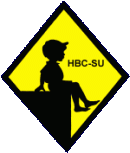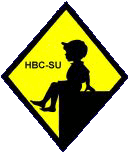
British-style peaked caps were commonly worn by America boys in the late-19th Century and very early-20th century. At the time they were worn by boys from a wide range of social strata. As these peaked caps were worn in England for cricket, it is likely that they were the inspiration for the now ubiquitous baseball cap. The early baseball caps worn by professional baseball players, for example, had very small peaks and looked just like school caps. After the turn of the entury boys continued to wear peaked caps Boys after World War I wore them more rarely., They were less common as flat caps bcame universal (1910s-20s). As flats caps declines in popularity, we begin to see more peaked caps.
Boys by the 1930s were beginning to dress more casually for school. But by his time caps were not as common as they used to be, but we see quite a few younger boys wearing them to school (1930s-40s). A good example is the boys at the Hardin Elementary School in Yongtown, Ohio (1948). These caps began to take on a kind of affluent family look by the 1950s and after the early-50s began to become less-common at schools. An American boy going to a public (state) school would have more likely worn a baseball cap which wrevgaining in popuarity (1960s). Peaked caps continued to be worn by younger boys through the 1960s, especially when dressing up in a suit--often a short pants suit.
American school boys, with a few exceptions have never worn uniforms until the late-20th century. Some exclusive boys' schools used them as part of the uniform, epecially schools wityh a British influence. good example is Frank Bailey about 1915. Some private schools continued to insist on more formal attire--including in some cases peaked hats which had acquired an upper-class look to it.
Related Chronolgy Pages in the Boys' Historical Web Site
[Main Chronology Page]
[The 1900s]
[The 1910s]
[The 1920s]
[The 1930s]
[The 1940s]
[The 1950s]
[The 1960s]
[The 1970s]
[The 1980s]
[The 1990s]
[The 2000s]
Navigate the Relate Boys Historical Clothing Uniform Garment Pages
[Main school cap page]
[Blazers]
[Bookbag]
[Coats]
[Hose]
[Kilts]
[Pants]
[Shirts]
[Shoes]
[Smocks
[Suits]
[Seaters]
[Ties]
Navigate the Boys' Historical Clothing School Uniform Country Pages
[Return to the Main Country Peaked School Cap Page]
[Return to the Main National School Uniform Page]
[Return to the Main School Uniform Page]
[Australia]
[England]
[France]
[Germany]
[Ireland]
[Italy]
[Japan]
[New Zealand]
[Poland]
[Singapore]
[Scotland]
[Singapore]
[United States]
Navigate the HBC School Section
[About Us]
[Activities]
[Chronology]
[Classrooms and buildings]
[Clothing styles]
[Countries]
[Debate]
[Economics]
[Garment]
[Gender]
[Hair]
[History]
[Home trends]
[Literary characters]
[School types]
[Significance]
[Transport and travel
[Uniform regulations]
[Year level]
[Other topics]
[Images]
[Links]
[Registration]
[Search]
[Tools]
[Return to the Historic Boys' School Home]
